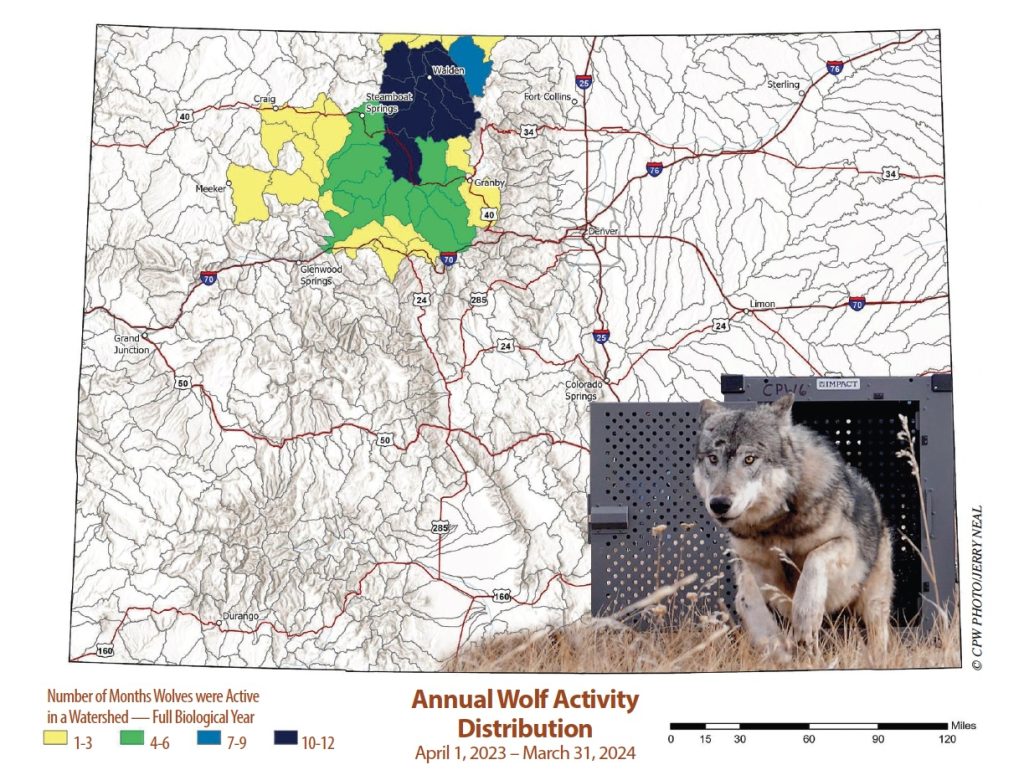 Where wolves in Colorado spent the most time between April 2023 and March 2024. The map uses watersheds. In order for a watershed to have wolf activity, at least one GPS point
Where wolves in Colorado spent the most time between April 2023 and March 2024. The map uses watersheds. In order for a watershed to have wolf activity, at least one GPS point
from a collar must have been recorded within the boundaries of the watershed in a month.
Colorado Parks and Wildlife/Courtesy photo
It has been eight months since Colorado reintroduced gray wolves into the state, the beginning of a multiyear effort to create a self-sustaining population of the predators.
On Wednesday, Sept. 4, Colorado Parks and Wildlife released its first annual report detailing the effort so far. It includes information on capturing and releasing the first 10 wolves and provides insight into the agency’s management, monitoring, research and more.
Rather than following a calendar year, Parks and Wildlife’s annual reports will follow a biological year. As such, the report shares data and information from April 1, 2023, to March 31.
The first 10 wolves were captured in Oregon and released in Colorado in December 2023.
According to the report, the first five wolves were captured on Dec. 17, 2023, and released in Grand County the next day. Another two wolves were caught on Dec. 18 and released in Grand the next day. Two more wolves were captured on Dec. 19 and released into Summit County on Dec. 20. The final wolf was released into Grand County on Dec. 22, having been captured the day before.
Six females and four males were released in total. Seven were 1.7 years old when captured and three were 2.7 years old. Eight had gray coats and two had black coats.
All these wolves have been monitored by Parks and Wildlife using GPS collars as well as ground and aerial observations, with the agency releasing a monthly report on where the wolves have been active. Using watersheds, the annual report indicates that while the predators spent time in several counties, the wolves spent the most time in Routt and Jackson counties during the biological year. This data includes the two wolves that were already in Colorado.
In keeping with its reintroduction plan, Colorado will release 10 to 15 more wolves this winter. While The Confederated Tribes of the Colville Reservation in Washington backed out as the source for these animals, Parks and Wildlife has indicated it is still on track to meet this goal. The wolves will also be released in the northwestern part of the state.
What the report doesn’t include
Because the report follows a biological year, it does not include information about the first pack and pups, the first wolf death, nor the majority of the depredations — all of which occurred after March 2024.
The first, and only, wolf death occurred in April, when one of the reintroduced animals was killed by a mountain lion.
The report lists one depredation in Jackson County where three sheep were killed by wolves. This incident occurred on Nov. 17, 2023, prior to reintroduction. The first livestock death by the reintroduced wolves occurred on April 2. Since then, there have been 15 confirmed depredations.
The first pair of reintroduced wolves reproduced sometime around April this year, with the litter of pups born in June. This Copper Creek Pack is being captured and relocated by the wildlife agency as it has been responsible for the majority of livestock killings.
What ‘translocation’ entails
While Parks and Wildlife has released little information about these relocation efforts, the annual report offers insight into what such an operation would entail.
According to the report, the first 10 wolves were captured in Oregon using a helicopter and spotter plane. Nine of these wolves were transported in aluminum crates to Colorado using a private aircraft, with the final wolf arriving in the state in a vehicle because it was the “most logistically feasible.”
The capture required 19 individuals, including 13 Colorado Parks and Wildlife employees, two biologists from the Oregon Department of Fish and Wildlife, the helicopter pilot and gunner, and another pilot and spotter biologist.
Before release, all of the wolves were given evaluations to ensure they could be eligible for relocation. While the majority of these requirements were related to the health and condition of the animals, it also included requirements that they not be from a “currently chronically depredating pack.”
While the annual report states that all 10 wolves were cleared for translocation, The Fence Post later reported that two of the released wolves were from a depredating pack in Oregon.
Conflict management
In the first months of reintroduction, efforts to minimize and mitigate conflict between producers and the wolves included nonlethal efforts only.
From April 2023 through March 2024, the agency reported that 7.25 miles of fladry were deployed at five locations, including seven projects in Jackson County.
“An estimated average of 200 pairs of cattle were protected for the five locations for a duration of 45-73 days,” it states. “For the five locations where fladry was deployed during the 2023 calving season, no livestock were lost to wolf depredation while the fladry was deployed.”
Funding for these nonlethal tools came from a $109,000 federal grant, $66,000 from the state’s wolf license plate, $15,000 from the Rocky Mountain Wolf Project and a general fund allocation of $2.1 million from the assembly.
According to the report, Parks and Wildlife received two requests to lethally remove depredating wolves during the biological year. These came from a North Park producer and the North Park Stockgrowers Association.
Both requests were denied as Parks and Wildlife and the U.S. Fish and Wildlife Service found they were not “chronic” situations, it adds.
At least one other request for a chronic depredation permit was made in May by the Middle Park Stockgrowers Association. This was also denied.
As the state navigates reintroduction, there is still a lot for all parties to learn. This includes several biological and ecological research projects led by Parks and Wildlife. The report indicates that several are already underway but are in the early phases. These projects will look at everything from the predators’ impact on elk, moose and other prey to the effect they have on livestock and human sociology, as well.
Source link : http://www.bing.com/news/apiclick.aspx?ref=FexRss&aid=&tid=66d9da3c0dd24a46bb2bcba3999410a0&url=https%3A%2F%2Fwww.summitdaily.com%2Fnews%2Fcolorado-wolf-report-first%2F&c=5847630957133499743&mkt=en-us
Author :
Publish date : 2024-09-05 05:11:00
Copyright for syndicated content belongs to the linked Source.
